
More often than not, a visit to the doctor these days unfolds like this – The doctor rebukes us and says that the cause of our sickness lies in our high-octane lifestyle where everything comes first except our own health.
And, we can’t help but agree with the doctor!
Today, people in their 20s and 30s have started visiting the medical clinics way more frequently as illnesses find easy ways into our homes and bodies.
Common Cold, nausea, headaches, eye irritation and dizziness have now become more commonplace than ever! Strangely, the cause has been in front of us all this time – indoor air pollutants!
These innocuous-seeming enemies thrive inside our homes and offices and wreck a havoc with our health. Interestingly however, you can defeat them indoors without much ado. After all, you need not visit the doctor to understand why prevention is better than cure.
Air Pollutants at Home – a Threat to Health
Whether at home or at work (research says that we spend about 90 percent of our time indoors), the air quality indoors can be infected by the very things that we use to add warmth and delight to our house and workspace. For many of us, our loved ones spend most of their time at home. In fact, homes are places we consider to be safe enough for our loved ones! But are they really safe?
Furnitures, furnishings, wall paints, air-conditioners, carpets, rugs, fumes and exhaust from cars in the parking spaces and even cleaning clothes and brushes release toxic chemical compounds into the air we breathe.
Worse still, when our cringed apartments (and sometimes even spacious houses!) lack proper ventilation and these toxic indoor air elements come to be our permanent roommates and co-workers.
NASA’s Verdict
Sometimes the solution to life’s biggest problems can be really simple. NASA proved this with their scientific findings and experiments (under NASA Clean Air Study in 1989) that led to the conclusion: Bring some Nature closer to your living and working spaces with the added benefit of purifying the air indoors.

Bonus – these plants are resilient to changing environments, need little care and look splendid even as they neutralise the pollutants releasing from your artifacts and decor items. Let’s call them our beautiful army.
How Can Plants help you Get Rid of these Undesirables?
When you place potted air-purifying plants in your indoor environment, this is what happens —
- They absorb some of the air pollutants just as carbon dioxide is taken by them to be converted into oxygen.
- The potting soil too helps with its little microbes in purging the air around and improving the indoor air quality.
Psychologically too, these air-purifying greens and oxygen bombs have a strong impact on reducing the level of stress or fatigue we feel, leaving a positive vibe for us to have a more alert and active presence.
Here are some air-purifying houseplants that we would like to recommend (the best for sure!)
Spider Plant
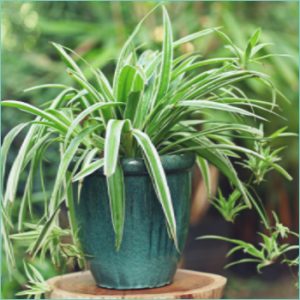 One of the best houseplant choices that purifies the air indoors. For novice planters or gardeners, these plants are a great bet as they don’t need you to be mindful of them all the time. Neither do they need direct sunlight — just place them on the side of a window for some indirect but bright natural light.
One of the best houseplant choices that purifies the air indoors. For novice planters or gardeners, these plants are a great bet as they don’t need you to be mindful of them all the time. Neither do they need direct sunlight — just place them on the side of a window for some indirect but bright natural light.
They also do well in cooler temperatures so your air conditioner would not make them shy.
From combatting particulates such as carbon monoxide to formaldehyde, the spider plant comes across as a protective shield for your home, garage or even workplace.
Peace Lily
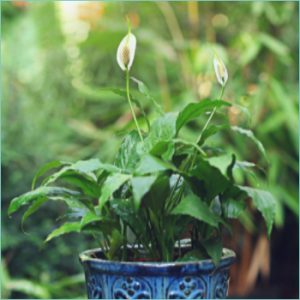
With pearl white flowers that grow through the entire summer and spread a beautiful floral scent all around, these plants stand true to their name and offer natural peace for your living and working spaces.
Introduce the dark, empty corners of your office or home to a peace lily and voila! That element of peace and warmth you had been missing all along is right there in front of you!
This is one of the rare houseplants that blooms beautifully with seashell-shaped flowers. It will bring life and some desirable humidity too during the dreary, cold winters.
Plant it in your bathrooms to keep your shower curtains and floor tiles free from mildew and to absorb alcohol vapours.
What’s More?
Ammonia, Benzene, toluene, formaldehyde, trichloroethylene and some volatile organic compounds (VOCs) found in paints and cleaning products are the common enemy for you and the Peace Lily.
Snake Plant

Also known as the Mother-in-law’s tongue (bizarre!), the Snake Plant thrives well in dry conditions and bright sunlight. Water it occasionally and place it in a pot in your bedroom for a sound sleep. Reason?
It releases oxygen at night!
This plant that grows only up to a maximum height of six inches is a power package when it comes to removing chemicals like benzene, trichloroethylene, formaldehyde, xylene and more.
Weeping Fig / Ficus Tree
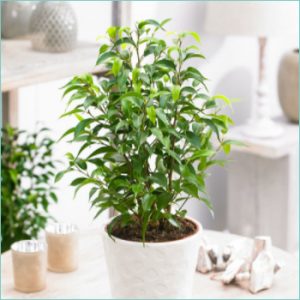
As an indoor plant the weeping fig can grow up to ten feet tall, is low on maintenance, needs indirect light and dry soil especially before watering it. Tolerant towards higher humidity levels, this plant can be placed both indoors and in the garden or balcony as well.
Suited best for living room, the fig effectively removes harmful airborne chemicals like benzene, trichloroethylene and formaldehyde, a compound found carcinogenic and asthma-inducing when present in high amounts. Get figging!
Florist’s Chrysanthemums
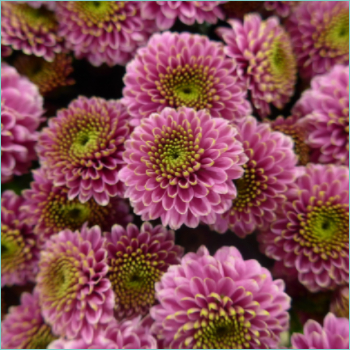
If you love bright colors and flowering plants, none can be a better option than Garden Mum or Chrysanthemums Morifolium that battles air pollutants – benzene, toluene, ammonia, xylene and formaldehyde for cleaner, fresher air.
This plant works best in its strive towards air-purification when put under direct sunlight.
A garden centre can provide you with beautifully blooming Garden Mums for your little garden indoors. Gerbera Daisies and tulips are some other colorful air-purifying choices but all of these plants need cool temperatures and scheduled watering.
English Ivy
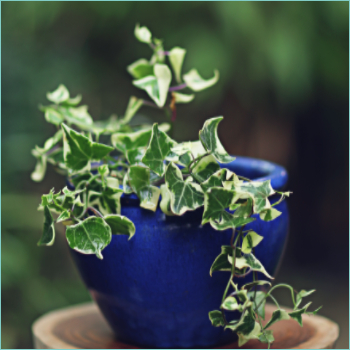
Keeping this plant at home means filtering out toxic elements from cosmetic products and even the germs in our bathrooms! Moisten the soil it is planted in and place it in direct sunlight for a few hours daily for this air-purifying champion to remove a host of chemicals from indoors – benzene, toluene, xylene and formaldehyde.
Add that subtle touch of decor whilst enjoying a breath of fresh air with this plant!
Dracaeana
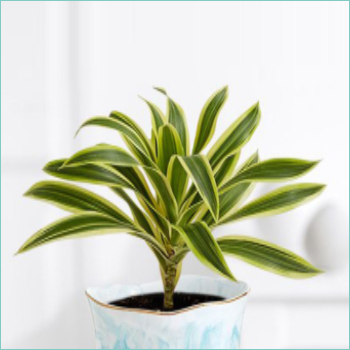
With a whole range of Dracaena plants to choose from, you can find one or the other Dracaena species that fits your indoor space perfectly! Whether you choose a Red-edged Dracaena or a Dracaena Janet Craig, their wide leaves can create a beautiful foliage. There are also some with variegated leaves of red, white, green, yellow and cream.
Dracaena Janet Craig is considered to be one of the best weapons against formaldehyde. Dracaena gets rid of benzene, formaldehyde and other VOCs when planted in indirect sunlight with moist soil.
The Red-Edged Draecaena blooms with white flowers and births red-orange berries – an ideal partner to beautify your living room.
Aloe Vera

One plant that is perfect for your kitchen windowsill or flower bed (not to say it cannot be kept elsewhere at your home) is the mighty Aloe Vera.
The gel from its leaves is useful for treating burns, wounds and even skin problems (always refer the Doctor before trying this at home!).
But it is put to its best use when purifying your indoor air off formaldehyde that hides beneath your floor finish and sticks together your particle board cabinets in offices (formaldehyde-based glues) and benzene – a common product in detergent and plastics.
Chinese Evergreen
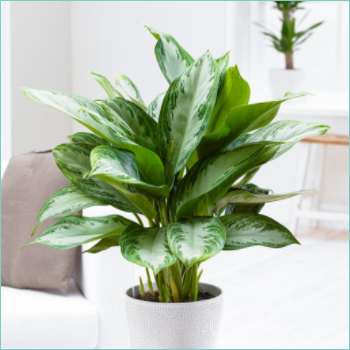
Getting hugely popular by the day, the Chinese Evergreen is known to be a great houseplant as it can grow even in highly humid and dim lighting conditions. Just an occasional misting of its leaves will sustain this plant for long so it can be your war weapon against benzene and formaldehyde in the air indoors.
Bonus – Belonging to the tropical climate, this plant adds the touch of tropics to your mundane indoor environment!
Broadleaf Lady Palm
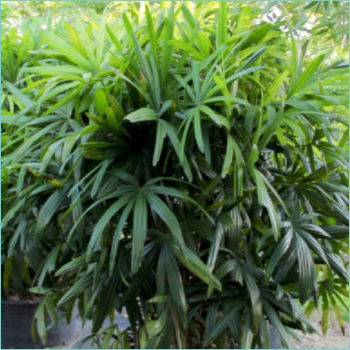
Ammonia can be a dangerous component in the indoor air – mostly found in cleaning ingredients. But when an air purifying plant with broad leaves sits beautifully in your living room or bathroom, ammonia and other such air particulates can never find a way into your home again!
***
If your house or office are screaming for some cleaner, fresher air and a safer environment, a touch of green can bring that change, much better than an air purifying machine.
Why, you may ask!
While the air purifying machine may get rid off the carbon dioxide in the air, it will not supply with fresh oxygen but living, breathing plants will!

However, when it comes to your personal or professional space, it becomes all the more difficult to choose the air-purifying houseplants best suited for your indoor environment.
Wouldn’t it be simpler had you had a guiding partner who you could reach out to for all your greenery concerns?
Our expert landscape gardeners, biophilic design creators and green designers will help you sort through oxygen producing and air purifying houseplants ideal for your home and work spaces. Over the past four decades, Ferntastica Gardens has worked on some of the most prestigious projects and the biggest names in the industry.
With an array of extensive work (includes design, development, execution, maintenance and more) that we have carried out for corporates, offices and landscape gardens, we have gathered valuable experiences & essential insights towards building sustainable workspaces that help in creating a healthier environment for everyone.
Ours is a legacy spanning 40+ years & three generations — rooted in creating and executing green solutions personalized for your tastes, needs and specific environments.
Cheers to a healthy lifestyle and breathing fresh air…even indoors!





